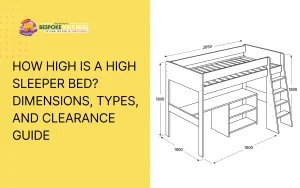
How High Is a High Sleeper Bed?
A high sleeper bed measures between 170 cm and 200 cm in total height, depending on the model and design. These beds create usable space
Enjoy FREE Delivery on All Orders!
As a parent, you always consider your children’s comfort and preferences when buying furniture for their room. But once that long-awaited bunk bed arrives, another question arises: who gets the top bunk and who takes the bottom bunk?
This isn’t just a debate at home. In hostels and dormitories, people often face the same decision when choosing between the upper bunk and the lower bunk bed. While the bottom bunk seems more convenient, the top bunk offers a sense of privacy and elevation that some people prefer.
So, is the bottom bunk better than the top bunk? This guide explores both options and helps you decide which one best suits your needs for comfort, safety, and practicality.
Choosing between the top bunk and bottom bunk depends on more than preference. Several factors, such as privacy, accessibility, temperature, lighting, and safety, play a role in finding the right fit.
Privacy is an important consideration, especially when sharing a bunk bed. The bottom bunk is often more exposed to movement in the room, while the top bunk offers slightly more separation and personal space. However, since the top bunk is still visible from many angles, it does not guarantee complete privacy.
The lower bunk bed is easier to access, particularly for children, elderly individuals, or those who move around frequently at night. There is no need to climb, and it allows quick entry and exit. The upper bunk requires climbing, which can be inconvenient for daily use.
Temperature can influence your choice between the top or bottom bunk. Since warm air rises, the top bunk often feels warmer, which is ideal for people who like a cozy sleeping environment. The bottom bunk generally stays cooler, making it more comfortable in warmer months.
Lighting conditions vary between levels. The top bunk receives more direct light from the ceiling, while the bottom bunk can feel dimmer. However, those sleeping on the lower bunk can easily place a bedside lamp or reading light within reach for added brightness.
Noise levels differ depending on the room layout. The top bunk may feel slightly quieter, as it is away from floor-level activity. However, in shared spaces, sound can travel in any direction, so neither bunk guarantees complete quiet.
Sockets and light switches are usually installed closer to the floor, making them easier to access from the bottom bunk. Those on the top bunk often have to climb down to adjust the lights, fan, or other devices, which may be less convenient during the night.
Comfort is subjective, but many people find the bottom bunk more spacious and stable. It allows you to sit upright and move freely. The top bunk offers a unique elevated feel that some enjoy, but it usually has less headroom.
The top bunk typically stays cleaner since fewer people touch or sit on it. However, it can be harder to clean or change the sheets. The bottom bunk may collect more dust and can be stepped on by someone climbing to the upper level, which may bother those who prioritise hygiene.
Safety is one of the biggest considerations, especially for young children. The bottom bunk is safer for those who move a lot in their sleep or are uncomfortable with heights. Although modern triple bunk beds and bunk beds with double on the bottom include guard rails for safety, the upper bunk still carries a slightly higher risk of falls.
Here are the main advantages and disadvantages of each to help you decide whether the top or bottom bunk is better for you.
The top bunk offers several benefits for those who prefer a more private and elevated space.
Despite its benefits, the top bunk comes with a few drawbacks to consider.
The bottom bunk is practical, safe, and comfortable for daily use.
While convenient, the bottom bunk has its own challenges.
If you prioritise convenience, safety, and easy access, the bottom bunk is the better option. It is ideal for children, families, or anyone who prefers a grounded, stable sleeping space.
However, if you prefer privacy, warmth, and a cleaner, elevated area, the top bunk might suit you more. It offers a cozy, independent space for older children or adults who enjoy sleeping higher up.
Ultimately, the choice between the top bunk and bottom bunk depends on individual needs, comfort, and room setup. Whether you are furnishing a shared family bedroom or a triple bunk bed, choose the level that best matches your lifestyle and comfort preferences.
Kyle Kane
Owner
Kyle Kane is Co-Owner of MK Furnishings, a family-run business based in UK that specializes in high-quality custom kids’ bunk beds, including triple, double, single, and themed designs. Since launching the company in 2016 alongside his brother-in-law, Kyle has helped deliver and assemble thousands of beds across the UK, Ireland, and beyond. Focused on customer satisfaction, Kyle leads a hardworking team that handles every step from ordering to delivery ensuring a smooth and professional service. His commitment to quality craftsmanship and reliable support has earned MK Furnishings a strong reputation and growing customer base throughout the region.

A high sleeper bed measures between 170 cm and 200 cm in total height, depending on the model and design. These beds create usable space

The right bed and mattress form the structural base to improve children’s sleep by providing proper spinal alignment and consistent support for their developing bodies.
Fancy £50 off all orders! Enter in 50off to redeem in the coupon code section